Early ripening sweet variety of honeysuckle Leningrad Giant
Russian gardeners grow more than 70 varieties of honeysuckle. One of the most beloved is the Leningrad Giant. Due to its resistance to adverse factors, blue honeysuckle is suitable for cultivation in the northern and eastern regions.
Description of the honeysuckle variety Leningrad Giant
This is an early ripening variety with very sweet fruits. He became a good donor for breeding new hybrids. It is distinguished by the ability to form berries into clusters that do not crumble.
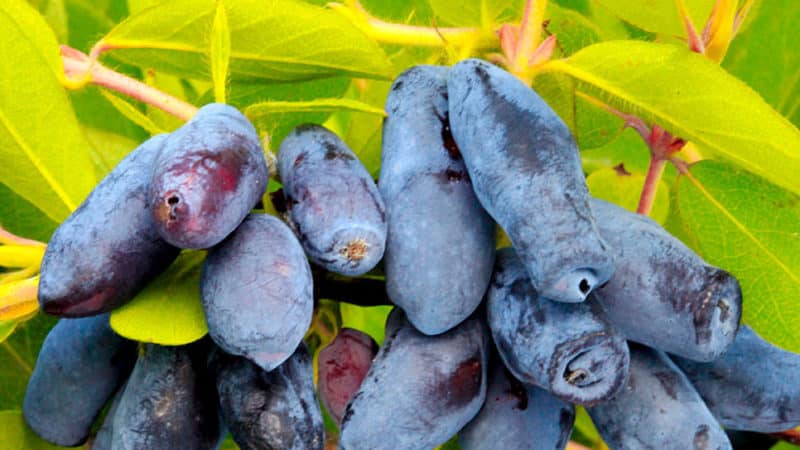
Origin and development
The variety was bred at the Pavlovsk station named after N.I. Vavilov in St. Petersburg under the leadership of M.N. Plekhanova. Obtained by seed from wild Kamchatka honeysuckle.
Characteristics, description of appearance, taste
It is a tall shrub up to 1.5-2 m high. After the end of the fruiting period, the bark acquires a brown tint and cracks, peeling off in long strips.
Some more features of the variety:
- leaves are dark green, oval, large, slightly elongated, 5 cm long, about 3 cm wide;
- the flowers are pale yellow, bell-shaped;
- The berries are dark blue and have the shape of an elongated cylinder with a rounded base.
The variety is self-sterile, blooms, but does not form an ovary. Requires additional pollinators in the form of edible honeysuckles Blue spindle, Morena, Blue Bird.
Honeysuckle is characterized by high taste.The berries have a thin but dense skin with a slight waxy coating. The pulp is tender, sweet and sour, aromatic. There is no bitterness at all. Tasting score: 4.8 points.
Features of application
This edible variety. The berries are consumed fresh and used to make jam, jam, and compote.
Productivity and fruiting
The yield of an adult bush is from 3 to 5 kg. With proper care and adherence to the watering regime, the bush is guaranteed to produce about 3 kg of berries. The length of the fruit is about 3 cm, thickness is about 2 cm, weight is from 1.2 to 4 g.
Fruiting is long lasting. Starts in July, ends in August.
Ripening period
The ripening period is early, late June - early July.
Resistance to diseases and pests
Honeysuckle is often affected by powdery mildew and the rhizome mosaic virus. The main types of pests are honeysuckle mites, scale insects, aphids, and leaf roller caterpillars.
Resistance to cold and drought
The Leningrad giant has good resistance to frost. Roots and shoots do not freeze at -40°C, flowers and ovaries do not lose viability during the growing season at -8°C. The bush is undemanding to heat, but in dry summers it requires regular watering.
Growing regions and climate requirements
Grows well in central Russia and north-west Russia. It develops well at low temperatures from -8°C and above without loss of properties.
Advantages and disadvantages of the variety
Advantages:
- massive berries;
- no bitterness;
- the shedding of overripe fruits is excluded;
- convenient to pick berries;
- high yield rates;
- stable fruiting;
- no tendency to re-bloom;
- excellent frost resistance;
- The bush is precocious - berries appear already in the 3rd year.
Flaws:
- requires pollinators;
- needs regular shrub formation.
Difference from other varieties and hybrids
Distinctive features are large fruits weighing up to 5 g, pleasant taste without bitterness, no shedding of overripe fruits, early fruiting.
Agricultural technology
Cultivation involves choosing the right time and place of planting. We also must not forget about further care, which will affect the quality of the harvest.
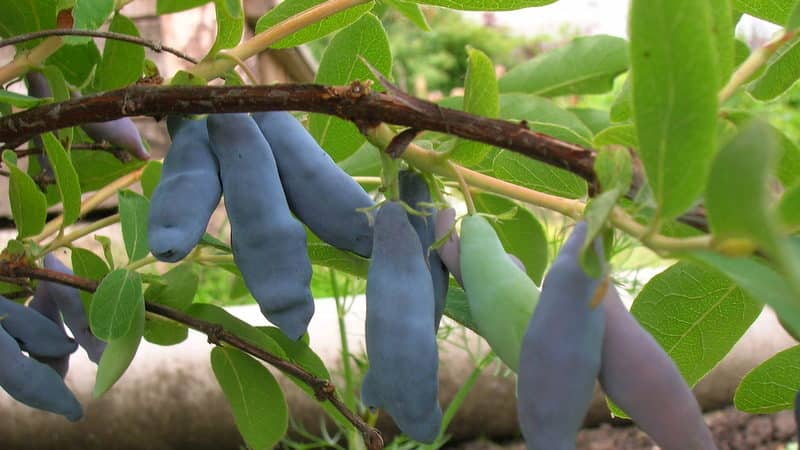
Choosing a place in the garden and preparing holes
Planting work plan from late July or early August to November. Choose an open area with plenty of sunlight. Honeysuckle cannot be planted in damp and low-lying areas, as the roots will be washed by groundwater. Excessive moisture will lead to the death of the bush.
During planting, soil and air humidity should be at least 85%. Air temperature - +20...+25°C, soil temperature - +15...+17°C.
The wells are prepared according to the following principle:
- Leave a distance between them of 2.5 to 3 m.
- Dig holes measuring 50x50 cm.
- Drainage made of crushed brick or expanded clay is poured into the bottom.
- Next, fill with earth consisting of 20 liters of humus, 30 g of superphosphate and 30 g of potassium salt or 500 g of ash.
2 hours before planting the bushes, the holes are watered abundantly. Then they wait until the moisture is absorbed and begin planting the plants.
Preparing for landing
Experienced gardeners recommend purchasing honeysuckle seedlings at the age of 3 years. Their height should be up to 40 cm. It is necessary to have 2-3 flexible branches with living buds. There should be no rot on the root system.
2 hours before planting, the roots of the plants are immersed in water. Growth stimulants “Kornevin” or “Heteroauxin” are added strictly according to the instructions.
Soil requirements
Optimal soil option - nutritious sandy loam mixture with neutral acidity (up to 5-7 pH). The condition of the soil is improved by adding 1.5 kg of dry vermicompost. The soil is dug up and watered abundantly.
Dates, scheme and rules of planting
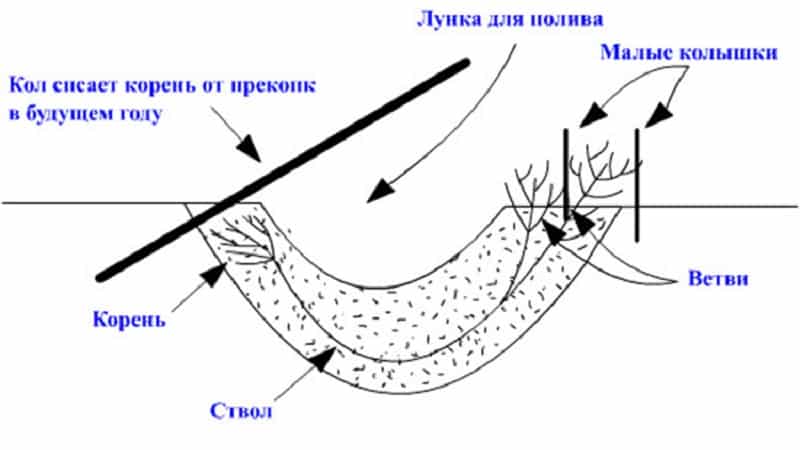
The best time for planting is from August to November. The dimensions of the holes are 50x50x50 cm, the distance between them is 2.5-3 m.
Step-by-step instruction:
- After moisture is absorbed, the hole is filled to the top with soil.
- Place the plant, carefully straighten the roots.
- They compact the soil well.
- The root collar is buried 5 cm into the soil.
- Form grooves around the bush and pour 10 liters of water into them.
- Straw or hay is laid out under the plant in a layer of 10 cm.
Landing prematurely has a negative effect on honeysuckle. The growing season begins at the end of March. During this period, the plant devotes all its energy to the formation and blossoming of buds and is not able to adapt to a new place.
Features of cultivation
The Leningrad giant needs proper care. The bushes are regularly inspected for diseases and pests and shaped. Experienced gardeners recommend alternating honeysuckle with dogwood, barberry, black currant, and pollinating varieties.
Honeysuckle requires regular watering, loosening the soil and fertilizing. An important nuance when growing it is pruning. Crown formation begins in the third season. Only 5 strong branches are left, the basal shoots and non-fruit-bearing small branches are completely cut out.
Thinning is carried out in the fall, after the leaves have completely fallen, at a temperature of about -3°C. Do not cut off the upper part of the shoots, since flower buds form there.
Watering recommendations:
- Over the entire season, honeysuckle requires 7 waterings, during the dry period - 14;
- one bush requires up to 15 liters of water;
- during the period of fruit filling, increase the volume of liquid to 30 l;
- pre-settle the water in the sun, bring it into the grooves made;
- water the bushes with a hose, irrigating leaves and branches to increase humidity;
- then loosen the soil, lay a layer of mulch from dry leaves or straw to prevent the evaporation of moisture from the soil.
Honeysuckle must be fed:
- Fertilizers are applied in the spring, starting from the third season.
- Recipe for nitrogen fertilizing: 2 tbsp. l. urea is dissolved in 10 liters of water, 2 liters are added to each bush.
- After the snow melts, mineral fertilizer is applied in the form of 10 kg of humus. Carefully dig up the soil around the plant.
- In the phase of formation of buds and ovaries, water with an ash solution. Recipe: 1 liter of ash is dissolved in 10 liters of water, 2 liters are added to each plant.
- In autumn, 5 kg of compost, 100 g of ash, 40 g of superphosphate per 1 square meter are added to the ditch. m. Every 2 years, potassium salt is added to this mixture in the amount of 15 g per 1 sq. m. m.
Pollinators
The best pollinators for the Leningrad giant are honeysuckle varieties Blue Spindle, Morena, Blue Bird.
Disease and pest control
The variety is affected by powdery mildew. The fungus attacks the plant during drought. Leaves and shoots become covered with whitish spots. Prevention includes regular watering and planting shrubs only in a well-lit place. Plants are treated with Skor and Vectra preparations strictly according to the instructions.
When affected by mosaic mosaic, the leaves become covered with reddish dots. Gradually they turn yellow and fade. Prevention includes weed removal and moderate watering. Plants are treated with HOM and Ditan M-45 strictly according to the instructions.
Pests:
- Aphid. The berry garden is placed only in a sunny area, the plantings are not thickened, mint, tansy, and chamomile are planted nearby.If there are ants on the site, treat with Anteater. Also use "Nitrafen", "Kilzar" according to the instructions.
- Honeysuckle mite. Signs: wrinkling of leaves and fruits. Prevention involves thinning the crown of the bush. The fight includes spraying with Decis and Inta-Vir according to the instructions.
- Leaf roller. Signs: curled, eaten leaves. For prevention, the soil is loosened and the berries are picked by hand. Fight - spraying with “Decis”, “Aktara”, “Biotlin” according to the instructions.
- Shield. Signs: growths on the bark, the berry plant dries out and dies. The fight includes burning diseased branches, spraying with Rogor and Actellik according to the instructions.
Preparing for winter
Honeysuckle does not require shelter. But on the eve of cold weather, it is watered with 30 liters of water, and a layer of compost is placed on the soil.
Reproduction
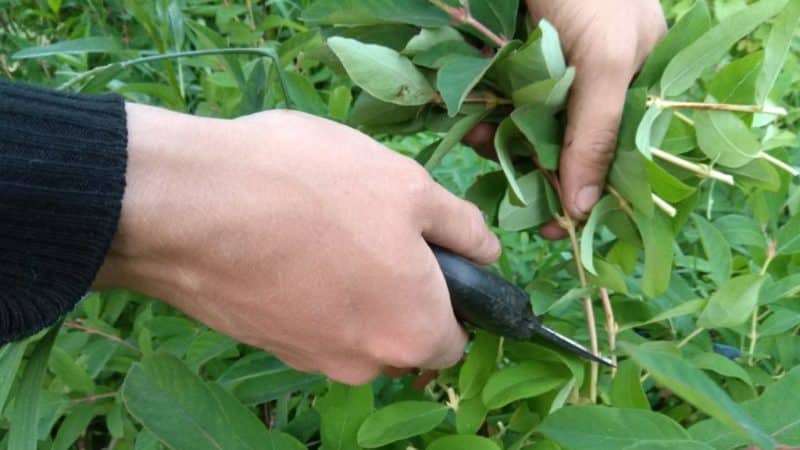
Produced in three ways:
- By division. At 5 years of age, at the end of summer, the bush is divided into parts with roots and 3 branches. New plants are planted in separate holes. The preparatory work is described above.
- By layering. In June, the top of the shoot is pinned to the ground, sprinkled with a 5 cm layer and watered. It is separated from the mother plant next year in the fall. Use the landing rules described above.
- By cuttings. The instructions are as follows:
- at the end of autumn, lignified annual growths are cut into pieces of 20 cm;
- place them in a box with sand or sawdust and send them to the basement until spring;
- after the snow melts, the cuttings are planted in the greenhouse at an angle of 45°;
- planted in open ground in the fall according to the rules described above.
Cuttings differ from other methods in the high survival rate of plants.
Difficulties in growing
There are no difficulties when growing honeysuckle Leningrad giant.Even beginners can handle this process very well.
Harvesting
The timing of fruit harvest depends on the growing region. But experienced gardeners advise using the rule: picking berries begins when birds appear in the garden, otherwise they will destroy the entire harvest.
How and when to collect
In central Russia, honeysuckle begins to be collected in mid-July. The fruiting period extends until August, so the bushes are regularly inspected for the presence of ripe berries. The fruits are collected in clusters. They are torn off, placed in the refrigerator or eaten immediately.
Tips and reviews from experienced gardeners
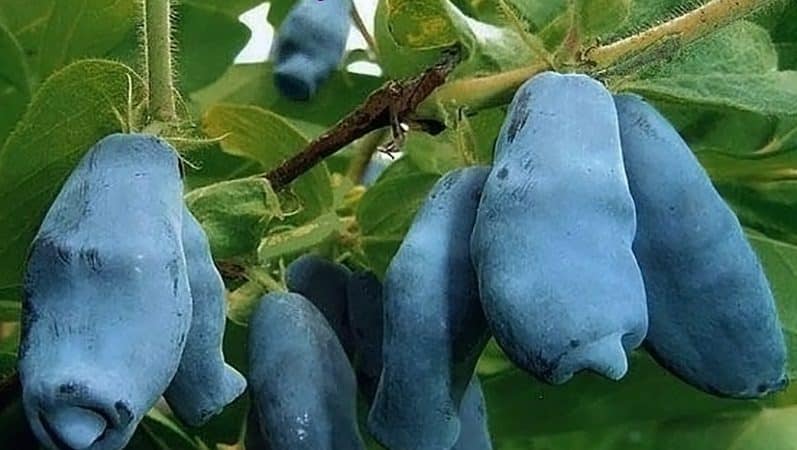
Recommendations:
- plant only bushes at the age of 3 years;
- choose a well-lit area for planting;
- observe the watering regime and the timing of fertilizing;
- inspect the berry garden for diseases and pests;
- do not forget about mulching the soil.
Gardeners speak positively about the Leningrad giant.
Elvira, Sochi: “The Leningrad giant honeysuckle grows well, the berries are very large. Their taste is much better than that of the Bakcharsky giant variety. There are a lot of bumblebees. But it’s not always possible to harvest because of birds.”
Irina, Tomsk: “The Leningrad giant honeysuckle has been growing since 2014, but has not yet lost its fruiting quality. The berries are large, tasty, and go well with homemade yogurt. I recommend mulching the soil around the bush in the hot summer.”
Conclusion
The honeysuckle variety Leningrad Giant has proven itself well among Russian gardeners. The plant does not require special care or a special climate for normal development. It is enough to follow the recommendations and advice of experienced gardeners, and then honeysuckle will delight you with a rich harvest.